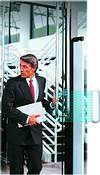

Ever since the first electronic article surveillance device was installed in a retail setting 30 years ago, retail security technology has played an increasingly important role in store operations. With inventory shrinkage costing retailers hundreds of millions of rands each year, retailers have increasingly turned to technology such as electronic article surveillance (EAS or tagging systems) and video surveillance to control theft.
As retailer demand has grown, so has the technology. The first somewhat large anti-theft tags have evolved over the years into today's wafer-like labels that can be attached or inserted into a variety of merchandise. As EAS technology has become more sophisticated, retailers now have much more flexibility with their systems, with the promise of much more innovation to come.
RFID
Today, EAS tags can be placed in the product, in the packaging, in price tags and on the product or packaging. Moving into the 21st century, one significant development in tagging promises to re-shape how systems are applied by retailers in the future, namely radio frequency identification, or RFID.
Often referred to as 'intelligent tags', RFID systems allow for noncontact reading and writing of tags, effectively converting them into portable databases. All forms of EAS technology (whether based on swept RF, electromagnetic, or acousto-magnetic) operate on some part of the radio frequency spectrum, and in effect, current EAS systems are no more than single-bit RFID systems, able to convey their presence, but not having sufficient data capabilities to convey an identity. The single bit status conveys an 'on' or 'off' status to a reader, making it suitable for use in anti-shoplifting systems. The ability to read, and potentially write more data to a tag opens up new realms of possibility in the securing, identification, tracking and tracing of assets.
A typical RFID system consists of a tag, reader and some sort of data processing equipment, such as a computer. RFID systems can be classified according to whether the tags are active or passive. Active tags have an on-board power source, such as a battery, and can transmit their information over relatively long distances. Passive tags obtain their operating power from energy generated by the reader, and are smaller, lighter and less expensive than active tags, but with shorter read ranges.
The significant advantage of all types of RFID systems is the noncontact, non-line-of-sight nature of the technology. Tags can be read through a variety of substances and in visually and environmentally challenging conditions, where bar codes or other optically read technologies would be useless.
RFID has already established itself in a wide variety of markets. Two widely recognised applications are the identification chips inserted under the skin of pets, and automated vehicle identification systems.
Efficient business management
For retailers, the potential applications and benefits of RFID technology are far-reaching. Systems enable companies to protect and manage their assets more efficiently through identifying and monitoring goods from manufacture, while in transport, in distribution facilities and in stores, providing significant enhancements to inventory control and management. Successful integration of such systems into supply chains is fast becoming a necessity for retailers to maintain competitiveness.
Retailers also stand to benefit from the efficiencies that RFID have brought to access control systems and to the automation of traditional, more cumbersome time and attendance systems, well-established applications in many other industries. RFID personnel identification can be further extended to restrict and control access to tills, overcoming the loopholes inherent in traditional password-protection and drawer locks.
Cost is currently the major constraint on the use of RFID tags at individual product level in-store. However, technology is developing rapidly, and economies of scale are already starting to bring costs down. Once a more widespread distribution becomes economically feasible, a wide array of efficiencies will be realisable.
With tags on products, inventory counting and stocktaking and marking stock down will become faster and more accurate. More detailed and up-to-date product information reduces the risk and costs associated with out-of-stocks and obsolescence. Within receiving bays, automated counting results in more efficient checking of deliveries against shipping documents.
Significant benefits stand to be had in the automation of returns. With the original sale price, location and sale date recorded on an item's tag, warranty fraud can all but be eliminated. And ultimately, the concept of customer self-checkout stands to become a reality, when readers at the till will identify the contents of shoppers' trolleys, with automatic debiting of credit cards.
In the UK, Marks & Spencer as well as Sainsburys are already testing the use of RFID to track and monitor perishable merchandise, and the logical extension of this is onto any out-of-date items such as fashion garments. Further down the track, RFID also promises to offer a wealth of information to enhance the effectiveness of in-store merchandising and marketing.
It is highly unlikely that RFID technology will ultimately replace barcodes. However, with the superior ability of wireless data communications technology to keep pace with the evolution of large-scale data management activities, RFID will undoubtedly continue to grow in its established niches.
For further details contact David Pople, DNA Sensormatic, tel: (021) 559 4425, e-mail: [email protected]

© Technews Publishing (Pty) Ltd. | All Rights Reserved.